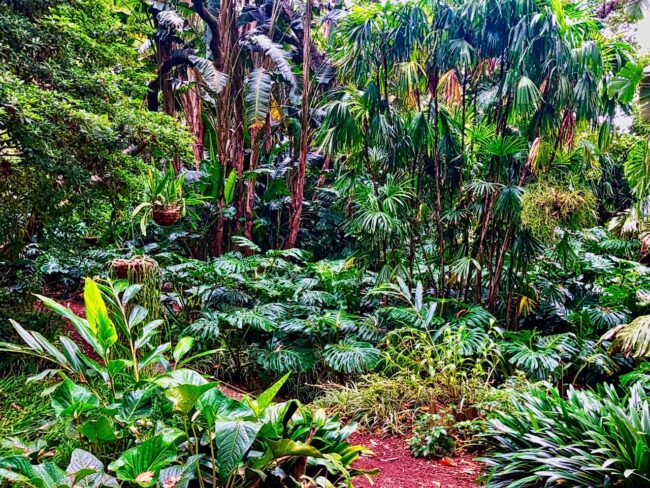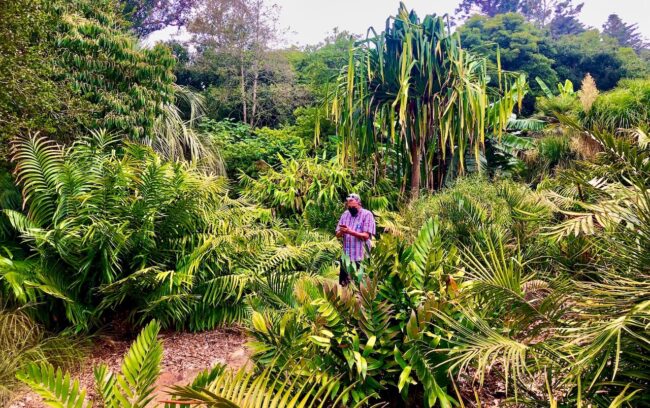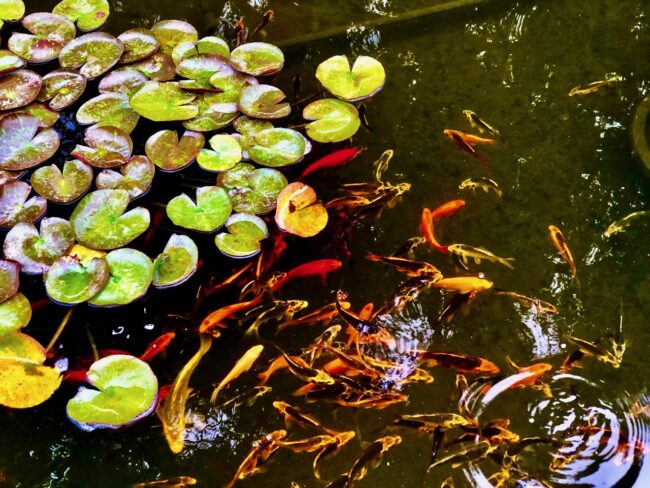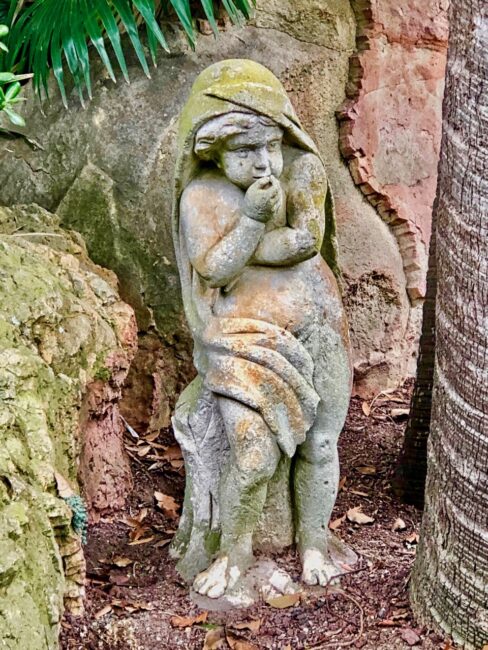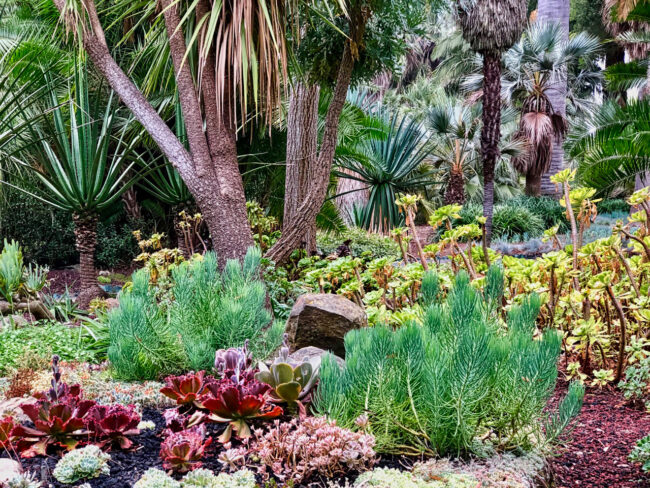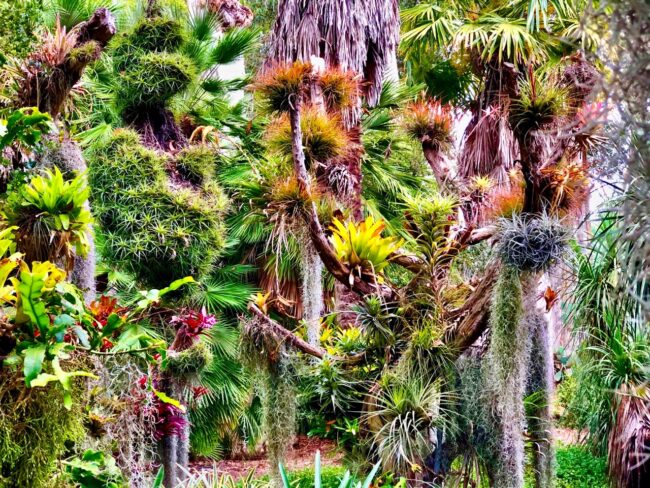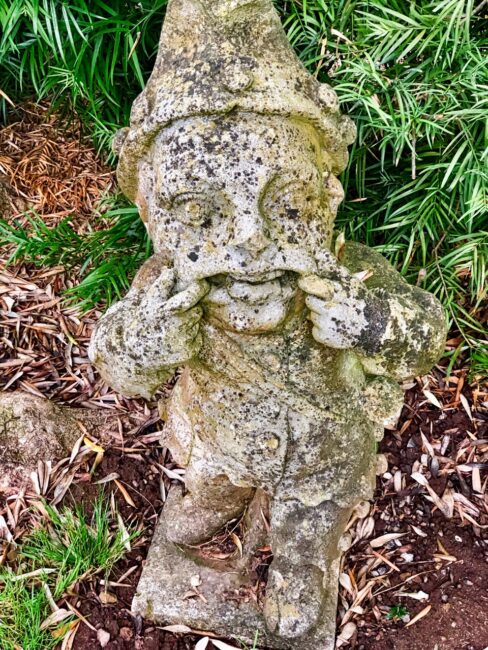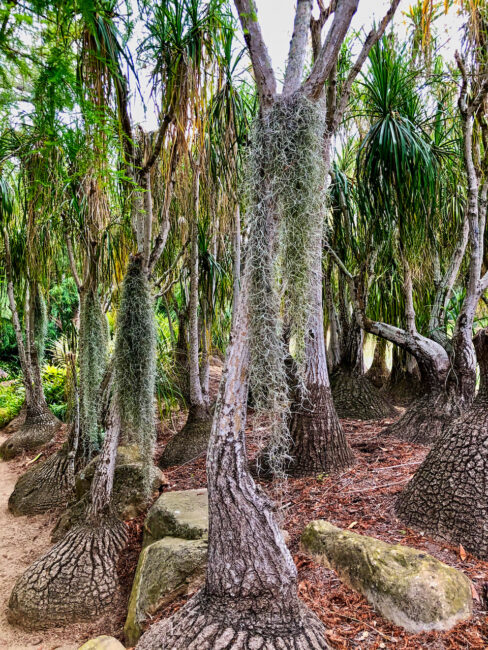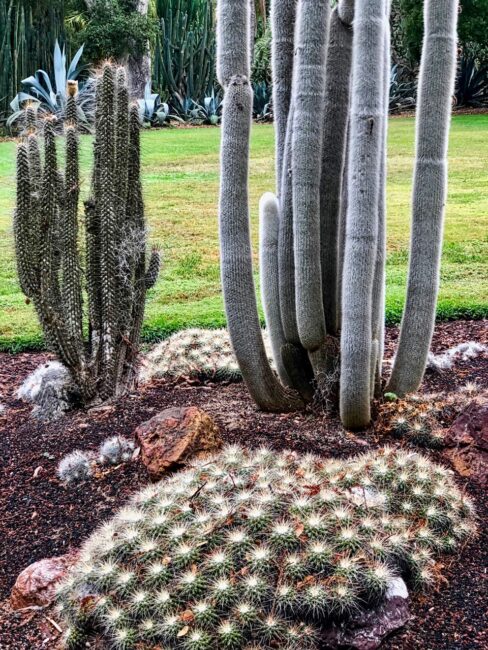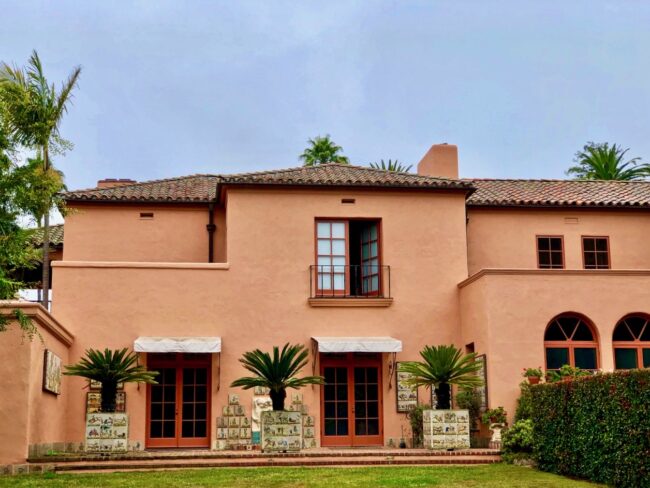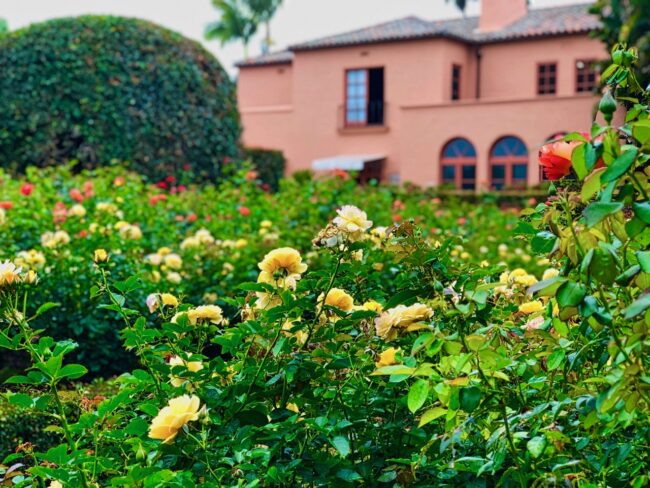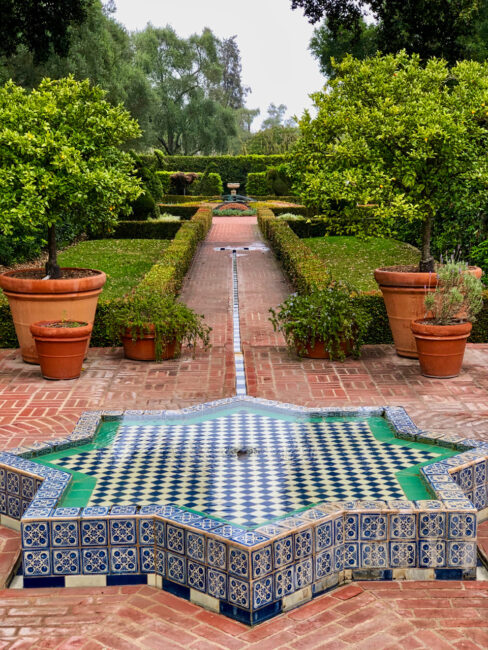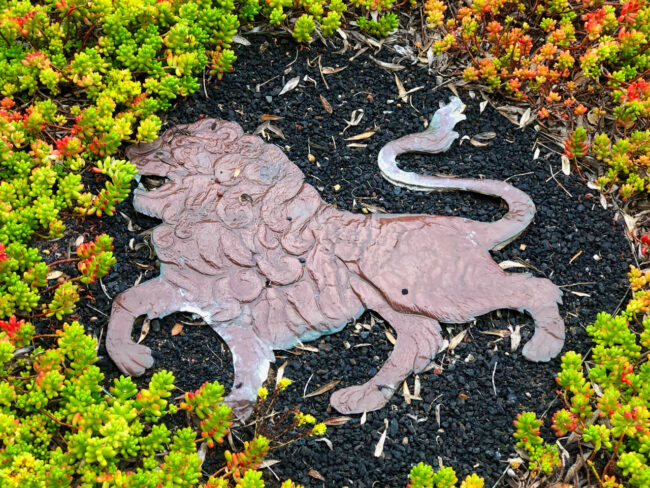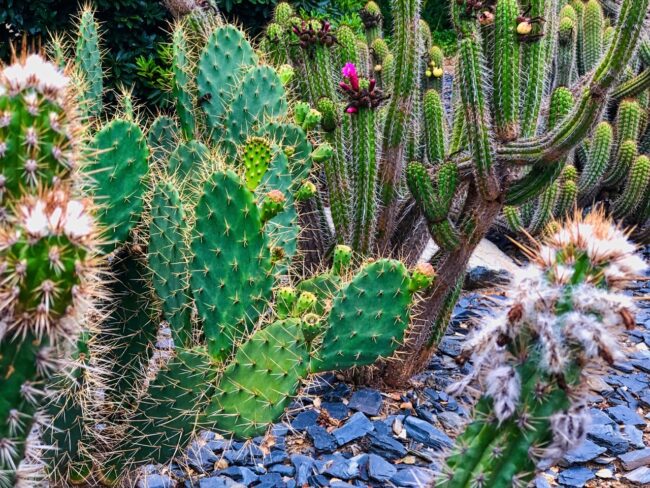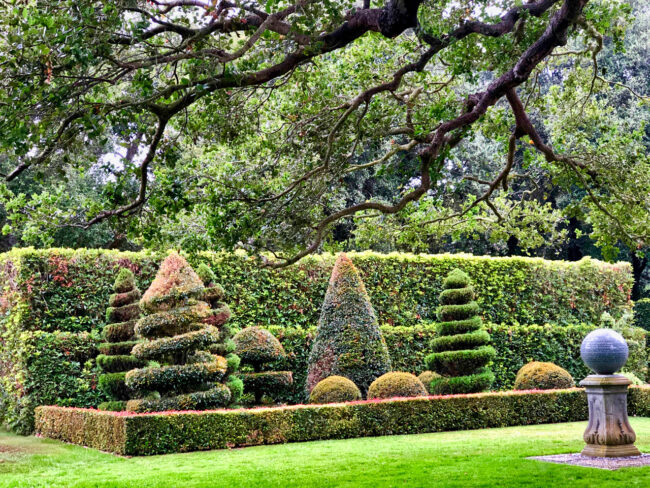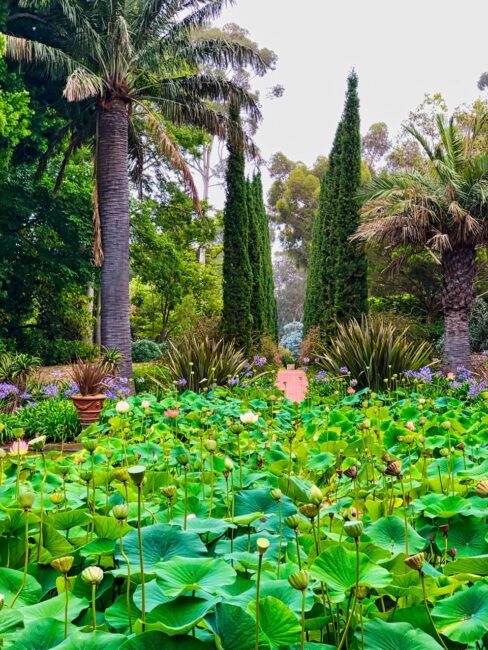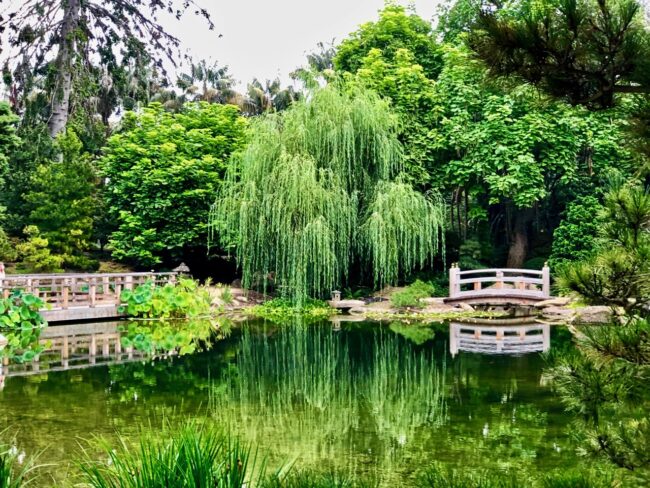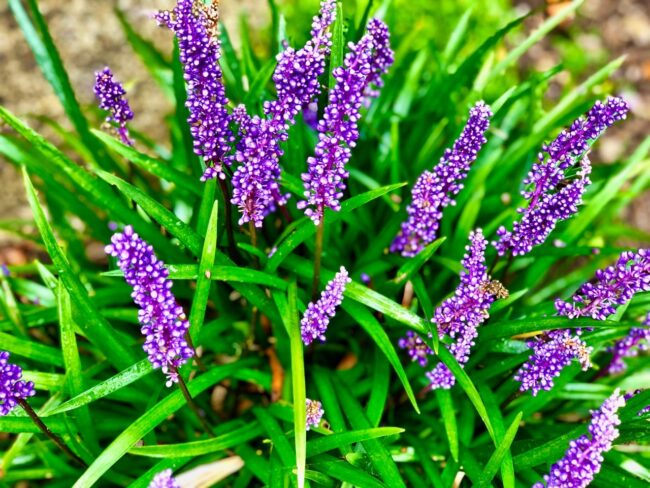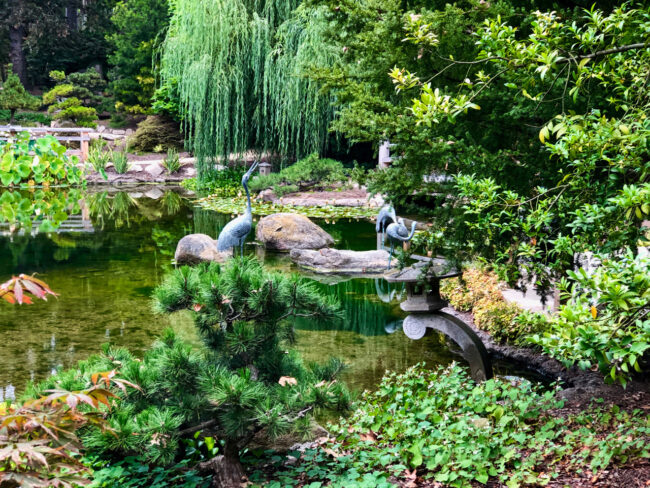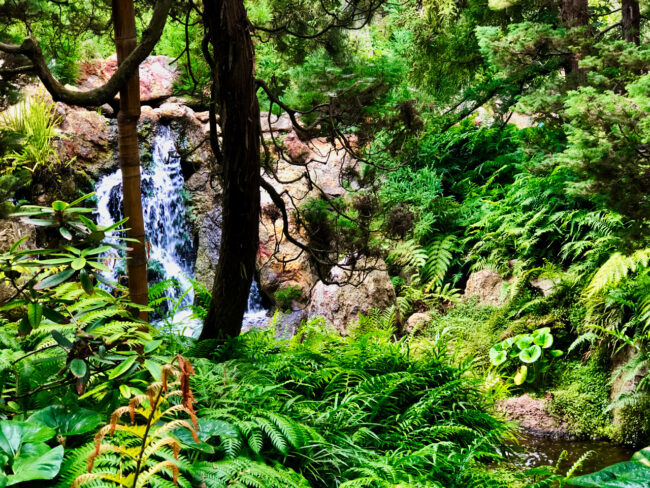
Descanso Gardens – La Cañada Flintridge
July 7, 2020
Bowers Museum – Santa Ana
September 29, 2020Magical & Mystical Gardens
Lotusland – Santa Barbara (Montecito)
Visited: July 2020
For the past couple of years, Tracy and I have talked about traveling to Lotusland, a 37-acre estate and botanic garden located in the Montecito foothills near the city of Santa Barbara. Lotusland actually features more than 20 unique gardens, ranging from roses to bromeliads, cycads, cacti and, of course, lotuses.
We secured 9:15 a.m. reservations by phone (the only way to get reservations), and on our 26th wedding anniversary we took the 90-minute drive to what has become one of our favorite garden experiences (and we’ve had a lot). It was so good, in fact, we will become members in 2021.
Lotusland, recognized by some as one of the Top Ten Gardens in the World, was the brainchild of Ganna Walska, a famed Polish opera singer, socialite and garden enthusiast. Her life story could be made into a movie.
In all, Walska was married six times, and, either by divorce or death of her spouse (four were quite wealthy), she accumulated enough money to create Lotusland at her Montecito mansion. Her husbands included a Russian baron, a multimillionaire sportsman and carpet tycoon, an industrialist, not to mention the English inventor of the death ray.
It also seems she was much better at transforming gardens than singing. According to a New York Times 1996 article, “during a performance of Giordano’s Fedora in Havana she veered so persistently off key that the audience pelted her with rotten vegetables.” Orson Welles recalled hearing about that performance, and many believe he created the character of the newspaper publisher’s second wife in the movie Citizen Kane after her.
She and her soon-to-be sixth husband purchased the property in 1941. It was originally called Tibetland, but after they divorced in 1946, she named it Lotusland.
Madame Walska created quite the unique garden experience. From the Lotusland website: “The spectacular collections of exotic plants on the 37-acre property are a personal expression of Walska’s penchant for the dramatic, the unexpected, and the whimsical.”
Walska passed away in 1984, and for the next nine years it served as a non-profit botanic garden. In 1993, it opened to the public.
We were the third car in line, and at 9:15 exactly the gates opened. We were told that masks were mandatory, an, because of limitations on the number of cars that can visit each day, that we would only have until 11:30 to explore the numerous gardens. As it would turn out, we needed more time.
Before checking out the gardens we walked under an arbor …
… toward the donors’ Wall of Honor.
The first path led us to The Tropical Garden.
In a Jurassic Park atmosphere we navigated the path on a cool, cloudy morning. We passed Swiss Cheese Plants (Monstera deliciosa)
I should have heeded the warning on Lotusland’s website. “Watch your head as you pass under an incessant Eucalyptus branch bending around multiple obstacles in search of sunlight. You’ll know what we’re talking about when you see it!” I saw it just in time.
 Fortunately, I narrowly averted certain death, so we could explore more of this garden.
Fortunately, I narrowly averted certain death, so we could explore more of this garden.
The following garden is referred to as Lotusland’s “Million Dollar Garden.” Madame Walska had a penchant for fine jewelry, after marrying her third husband, multimillionaire Alexander Cochran. Cochran’s wedding present to her was “to go with Carte blanche to Cartier and choose anything’ she desired.” The development of Lotusland’s Cycad Garden “coincided with the auction of Madame WaIska’s enormous jewelry collection (in 1971), and was the last garden created by Madame Walska.”
Speaking of Jurassic Park, the Jurassic Period is sometimes called the Age of Cycads. There are more than 450 different different specimens, making this one of the “most complete in any American public garden.” Cycads can be either male or female. I believe the one on the right is a female cone-bearing-plant. Well, I do have 50/50 chance of being correct.
Meanwhile one intrepid visitor was still trying to figure out how to get the QR codes of the gardens on his phone …
… while Tracy was nearly devoured by a Sago Palm. “Get your palms off of me!”
A koi pond loomed ahead.
Today, the koi were certainly not coy. It looked like it was baby season, too. Pick a carp, any carp.
I believe this colorful guy (or maybe girl) is an Encephalartos Senticosus Lebombo Cycad, but please don’t hold me to that. As you can see, the colors were vibrant.
As we neared the end of the Cycad Garden …
… we traveled forward in time from Jurassic Park to a sign of modern times. I need one of these for our house.
We passed by the entrance to the Japanese Garden, which would ultimately be our final stop of the day …
… and began our stroll through the Succulent Garden.
As well as succulents, there were a number of Cherub statuettes. It seems as though Madame Walska liked to place artifacts throughout the gardens.
They were once situated in the Theatre Garden (we’ll be in that garden soon), and represent “classic mythological characters.” The guy on the right looks like a young Bacchus, the Roman God of Wine. It doesn’t look like it aged well.
There are also other whimsical features Madame Walska placed throughout the gardens.
The Succulent Garden was created in the 1940s and renovated in 1973.
The vivid colors of many of the succulents popped off the chart. It was then on to the very vibrant Lower Bromeliad Garden. As we entered. we saw a tree, which looked like it had netting thrown on it. These Spanish Moss drapes gracefully adorn many of the trees throughout the gardens and looks artfully glued on. As we’d learn, Spanish moss used to be quite an important economic plant back in the day. It was used to stuff pillows and furniture cushions. Of course, the Rolling Stones gather none of it.
It was then on to the very vibrant Lower Bromeliad Garden. As we entered. we saw a tree, which looked like it had netting thrown on it. These Spanish Moss drapes gracefully adorn many of the trees throughout the gardens and looks artfully glued on. As we’d learn, Spanish moss used to be quite an important economic plant back in the day. It was used to stuff pillows and furniture cushions. Of course, the Rolling Stones gather none of it.
And, as it turns out, Spanish Moss is not a moss … and it’s not Spanish. It’s a bromeliad native to many countries … none of them called Spain. French explorers called it “Spanish Beard,” because it reminded them of the Spanish conquistador’s long beards.
The bromeliads were fascinating.
There are more than 3,000 various species of bromeliads.
It was our favorite of the Lotusland Gardens.
This particular bromeliad looks as if there is a human face in the center (click the photo on right to enlarge) …
… while the one on the left looked like a weird ear of corn.
Mai Tai Tom Fun Fact: The most commonly known bromeliad is … the pineapple! It is the only bromeliad that produces a fruit that can be eaten. Coincidentally, it’s good in a mai tai.
We wandered the Lower Bromeliad Garden for quite a long time …
… until we remembered we only had 2 hours and 15 minutes to explore Lotusland.
We walked quickly through the Shade Palm Garden …
… and found ourselves at the entrance to the Theatre Garden, which showed off the playful side of Madame Walska.
Madame Walska loved Paris. She first moved there in 1914, but returned to the U.S. during World War I, crossing the pond once again in 1929, after being separated from her fourth husband, Harold McCormick, the chairman of the International Harvester Company. A “self-proclaimed feminist, she also loved theater.” She moved back to the U.S. when World War II broke out, leaving many of the stone figures she had acquired in her Paris garden.
Once the war ended, she was able to retrieve her “grotesques” back and create her Theatre Garden at Lotusland.
Most of these figures have physical deformities. Tracy liked this gentleman.
This hunchback, although from Paris, never appeared at Notre Dame Cathedral. I thought I heard him say, “What hump?”
You had to tip your hat to this guy.
Same to you buddy!
Walking back through part of the Lower Bromeliad Garden toward the Great Lawn, we saw a couple of roosters. Not real ones, but ones made out of lead. The rooster is an “unofficial symbol of France,” and I’m cocksure the Coq Gaulois (Gallic Rooster) decorated French flags during the French Revolution.
Near the Great Lawn we spied several more trees draped in Spanish Moss.
Lotusland has a number of interesting looking trees.
This cactus plant also caught our eye (thankfully, not literally).
It was here that we ran into a gardener who has worked at Lotusland for 41 years. He is one of 12 people who tend to the gardens and told us that only 15,000 visitors are allowed per year (and even less now during Covid). His favorite garden is the Lower Bromeliad.
We made a quick trip through the tip of the Blue Garden, where we realized we needed to step up the pace to finish by 11:30.
The plants we saw weren’t as blue as I thought they’d be, however many did have a blue hue to them. We need to come back and further explore here.
Next we walked by Madame Walska’s Mediterranean mansion, designed by Pasadena architect Reginald Johnson. He also designed the Santa Barbara Biltmore and numerous other buildings.
As we walked toward the Rose Garden, the Neptune Fountain greeted us, complete with Spanish tiles. Behind Neptune are two merman, however Ethel was nowhere to be seen.
It was nearing the end of rose season, so we moved on …
… witnessed the fruits of our labor.
We passed by the eight-ray Moorish Star Fountain and a small channel that led to the Zodiac Clock in the nearby Topiary Garden.
The Topiary Garden once again shows off Madame Walsky’s whimsical nature with 26 topiary figures of different animals.
I’d have walked a mile for a camel.
It’s not often you see a mythical hippocampus (half horse, half sea monster) galloping nearby. I guess if you cut that horse part in half it would become a quarter horse.
The centerpiece of this garden is the working Zodiac Clock that measures 25 feet in diameter. The clock dates back to 1955 and was renovated in 1998. There are three different succulents, and the clock features copper zodiac signs.
Of course, we had to take a picture of the greatest of the Zodiac signs … Leo!
We hightailed over to the Cactus Garden. Ever since we visited the Cactus Garden at the Huntington Library, we’ve really enjoyed them at other nearby gardens.
This collection of cacti started back in 1929 and they were shipped up from San Diego. More than 500 plants were transported.
We were told the best time view this garden is February and March, when the kaleidoscopic flowers of these cacti are stunning When in full bloom..
It wasn’t too shoddy in July, either.
Time was growing short and we still had a few gardens that we really wanted to see.
On the way to the Water Garden we once again passed by the mansion. Some of the surrounding foliage dates back to 1942.
The most intriguing plant in this area is the weeping Euphorbia ingens, the iconic tall plants growing alongside the mansion. Only a few remain, but one is in decline and will probably have to be removed. The limbs almost look like could become alive and swoop down to pick you up.
With less than hour until we had to depart we headed toward the Water Garden.
It is called Lotusland for a reason.
When it was build in the 1920s, the pond was utilized as a pool by its previous owners. The pool leaked when Madame Walska bought the house, so she filled it with soil and gravel. it now has a depth of three-feet and is a water garden holding many of Lotusland’s eponymous flower. You had the full gamut from lotuses getting ready to bloom to lotuses in full bloom …
… to lotuses turning to seed after blooming.
You could say this garden was blooming wonderful.
The best time to see the lotus flowers in their full glory is usually between June and September. Our docent here (there are lots of helpful and informative docents at Lotusland) told us that the bloom was a little early this year, but as you can see many were ready to pop open in the future.
 This garden was well worth the wait, but we still had two more to visit.
This garden was well worth the wait, but we still had two more to visit.
Aloe vera has been my friend for numerous cuts and burns over the years, so it was nice to see my friends growing in the Aloe garden.
The center of this garden is the kidney-shaped Abalone pond.
This time, Madame Walska took a swimming pool and turned it into “an abalone shell pond.”
 Iridescent abalone shells line the outside of the pale turquoise pond.
Iridescent abalone shells line the outside of the pale turquoise pond.
They also also make for a dazzling water feature.
As we found out from another docent, Aloe vera is just one of more than 600 plants in the genus Aloe.
The plants grow from South Africa and Madagascar to the Arabian Peninsula. I have no idea the variety of these aloes, but they are colorful.
We still had 25 minutes, and our final stop would be the recently renovated Japanese Garden.
The Japanese Garden was the most important part of Lotusland back in the 1960s. Madame Walska had a “skilled Japanese gardener” named Frank Fujii, whose dad helped create the Japanese Garden at Golden Gate Park in San Francisco (see our adventure at Golden Gate Park). Fujii retired at the age of 86 in 2007. (photo of Mr. Fujii courtesy of Lotusland)
The garden underwent a $6 million two-year restoration project and re-opened in 2019.
The Reflecting Pond is full of koi, lotuses, waterlilies and Japanese irises. The lotuses here have an interesting story.
They come from Echo Park Lake in Los Angeles (read about our morning at Echo Park Lake). The lotuses at Echo Park Lake were imported from China back in the 1920s. Eighty years later they started to decline, and by 2008 there were no more lotus flowers in Echo Park Lake.
What could they do?
Well, it seems that In 2005, horticulturalist Randy McDonald violated the Los Angeles municipal code by pilfering a cutting or two from one of the lotus plants in Echo Park Lake. When the city began planning to drain and restore the lake, the landscape architect of the project found out about McDonald’s secret. McDonald fessed up to stealing the cuttings, and soon afterward he discovered that sometimes crime REALLY DOES PAY. There was talk of bringing in other species from other countries, but eventually McDonald ended up selling 376 lotus plants he had cultivated in exchange for $30,000.McDonald had also shared the plant with a few nurseries … one being Southwest Aquatics in central California. The lotus plants in Lotusland’s Japanese Gardens are from the original plants from Echo Park lake, which they purchased from Southwest Aquatics. Small world.
We strolled around the path patterned after 17th century Japanese “Strolling Gardens.”
A mini-waterfall provided the only noise in this scenic …
… and peaceful part of Lotusland.
Nearby are The Water Stairs and Cypress Allée. The series of 14 stairs makes for a water walkway that heads down to the Japanese Garden pond.
There are also 30 stone lanterns placed throughout the garden.
There’s some water creatures, as well.
The clock struck 11:30 a.m., and sadly it was time for us to leave the Japanese Garden and Lotusland …
… but not before checking out the gift shop, which has some items that denote Madame Walska’a whimsy.
Our journey to Lotusland was nothing less than spectacular. Every garden provided unique plants and flowers that really dazzle the senses. As Tracy said to one of the docents, “I could have spent all day here!”
As of July 2020, only 35 cars are allowed in the morning and another 35 in the afternoon (40 each on weekends). You can have no more than six to a car. You must make reservations by phone (we made ours about three weeks in advance). They also have guided tours, which we would love to do.
If you live in Southern California or plan to visit, there is no place I recommend more highly than this unique slice of heaven. It’s a place where you can lose yourself, and for at least 2 hours and 15 minutes, take your mind off all the craziness in the world. We still have many more gardens to explore (and re-explore) at Lotusland.
Well done Madame Walska! Thanks Lotusland. See you soon!
Lotusland
Cold Spring Road
Montecito, CA 93108
(they will provide directions … your GPS will probably not work up here)
Open: Mid-February – Mid-November
Reservations: 805.969.9990
Self-guided tours:
Wednesday – Saturday 9:15, 9:30, 9:45 a.m. &
1:15, 1:30, 1: 45 p.m.
Guided Tour: Wednesday – Saturday 10 a.m. & 1:30 p.m.
Membership Fee: (Yearly) $165 for two people
Admission: $50 (if you subsequently decide to be a member, they do not apply the admission fee to the membership fee)
Parking: Free












